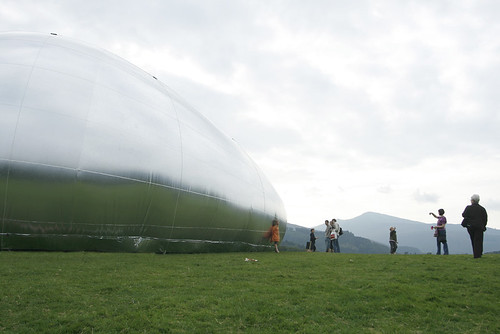Previous:
Father and son were watching the DVD "Harry Potter and the Philosopher's Stone" together from the comfort and warmth of Josh’s bed, but Josh wasn’t ready to sleep even when the movie had finished. The invisibility cloak had fired his imagination.
“Pa, is an Invisibility Cloak for real?" asked Josh, "Can I get one?”
Rosh settled back with a smile. “Yes Josh,” he said, “They are a scientific reality now but the technology is not perfect yet."
"Inspired by the natural phenomena that causes desert mirages, researchers at the USA University of Texas at Dallas NanoTech Institute created some carbon nanotube apparel in 2011."
![Invisibility Cloak [Cultural Mysticism]](http://farm5.staticflickr.com/4047/4498870318_f8a6357676.jpg) "When super-heated by electricity, the temperature difference created between the cloak and its surrounding area causes light to bend away from the wearer."
"When super-heated by electricity, the temperature difference created between the cloak and its surrounding area causes light to bend away from the wearer."
"They used sheets of carbon wrapped up into cylindrical nanotubes."
"Each page was only as thick as a single molecule, but as strong as steel because carbon atoms bond extremely tightly."
"Like silica, which makes up sand, Carbon is an excellent heat conductor, making it an ideal mirage-maker.”
The Wonder of Mirage
 “Pa, what is a mirage?”, Josh asked.
“Pa, what is a mirage?”, Josh asked.
“They are illusions son. The scientific name of the mirage effect is photothermal deflection, derived from the Greek photos- meaning 'light'."
"Light gets deflected due to 'thermal' which means heat, or stiff temperature difference between sand and air in a desert."
"This causes a "puddle" of sky to appear on sand which our logical (and thirsty) brain interprets as a pool of water."
"In comics, desert mirages are shown as vivid tropical oases with lots of palm trees and water."
"In animations, they spring up suddenly in the hot desert, and just as suddenly disappear. Just like the proverbial pot of gold at the end of a rainbow, one can never reach them."
"Mirages do really exist though, but not quite like they are illustrated in cartoons and movies. "They can make you see water where there isn't any."
"In really hot times, you can sometimes see distant stretches of the road appearing to gleam with pooled water, but there is nothing actually there when your car passes the actual spot.”
“But Pa,” asked Josh, “How can light bend? I’ve never seen it do that before.”
“You have son, but you haven’t made the connection. Light is a very interesting thing, and it does lots of interesting things all around us, all the time. It lets us see things."
"Our world is colorful because we have light. Do you know there are some places on our Earth so deep, like the Mariana Trench, where light never reaches."
"Life that exists in such parts is adapted to such dark environments."
 "So, it is quite different from all life, including us, which lives in light."
"So, it is quite different from all life, including us, which lives in light."
"Similarly, large parts of space in the sky above us are dark."
"Remind me to talk to you about how fascinating light is one day."
"But tonight, I’ll just remind you that the spoon that looks disjointed in a glass of water, the sunbeam that angles through the slits in clouds, and even the rainbow that appears after a storm are just examples of light bending."
"This invisible cloak also uses the same principle, but the problem is that it is a tiny, super-heated outfit that has to stay immersed in water.”
 Cloaking with Metamaterials
Cloaking with Metamaterials
“Another promising option though is clothes made from metamaterials, which were first conceived by the Russian physicist Victor Veselago in 1967."
"Metamaterials are tiny artificial structures smaller than the wavelength of light, which can guide rays of light around an object just like a rock diverts water in a stream."
"They show negative electromagnetic properties as opposed to positive electromagnetic properties shown by all natural materials."
"These electromagnetic properties affect how an object interacts with electromagnetic fields.”
“Remember, we see images via light waves. And hear sounds via sound waves. If we can channel these waves around an object, we can effectively hide it from sight or sound. Both types of cloaking are now reality."
"Optical cloaking is hiding things visually, and Acoustic Cloaking is hiding things so they can’t be detected by sound. Ships and sea creatures find things not by seeing, but by using sound echoes or sonar."
"Acoustic cloaking for audible frequencies has only recently been achieved, even though it had been tested successfully in frequencies humans can't hear earlier. In 2011, Dr Cummer of Duke University showed an acoustic cloaking technique that works in air between one and four kilohertz."
"That is within our audible range and corresponds to two octaves on the higher half of a piano. BBC reported that this cloaking shell was made of easily-manufactured sheets of plastic with holes through them."
“Last year, Duke University's David Smith had created a metamaterial fabric that could distort the flow of microwaves just like oil deviates water flowing towards it. This material was made of concentric rings containing electronic microwave distorters."
"When activated, they steered specific frequency microwaves around the central part of the material. Humans can't see in the microwave spectrum, but he proved that energy waves could be bent around an object.”
“Let’s go back to our rock in the stream example. After water goes around it, it continues downstream in the same direction as if the obstacle never existed in its path. If the light waves could do the same thing, continue around an object and straighten back on their previous path or direction, they would cloak to sight what they go around."
"Imagine Harry Potter’s cloak now diverting visible spectrum light coming from Professor Snape’s direction and straightening behind Harry. If Harry’s cloak could do that, Harry would truly be invisible to Professor Snape, although as shown in the movie, Professor Snape could still sense someone around, say because of his smell or whatever.”
 “The University of Maryland's Igor Smolyaninov has created just such a metamaterial this year, which can bend visible light around an object."
“The University of Maryland's Igor Smolyaninov has created just such a metamaterial this year, which can bend visible light around an object."
"Though only 10 micrometers wide, this cloak used concentric gold rings injected with polarized cyan light."
"These rings steered incoming light waves away from the hidden object making it invisible to the human eye."
"Problems again were that the cloak was tiny, limited to two dimensions, and weighed heaps because of the contraptions”
Optical Camouflage using Retro-reflective Projection Technology
“Another commonly used technology is Optical camouflage, which works on the same principle as the blue screen used by Hollywood filmmakers. You saw this in action when you visited Movie World some years ago."
"Where Optical Camouflage becomes so exciting is when used with a high-tech fabric and Retro-reflective Projection Technology developed by scientists at the University of Tokyo."
"Its retro-reflective material is covered with thousands of small beads. When light strikes one of these beads, it bounces back exactly in the same direction from which it came, which is not what light usually does."
"This makes a spectator situated at the light source receive more of the reflected light and therefore see a brighter reflection.”
“Retro-reflective materials are quite common, as you already know. Traffic signs, road markers and bicycle reflectors all use retro-reflection to be more visible to people driving at night."
"Movie screens in most multiplexes also use this material, creating a better viewing experience than Home Theatre Systems, because it creates high brilliance under dark conditions. So, what makes retro-reflective material so special in optical camouflage is they can be seen from far away and outside in bright sunlight.”
“William Harris and Robert Lamb explain exactly how Optical Camouflage is done with this retro-reflective material in their article ‘How Invisibility Cloaks Work’. To make people see through you, what is behind you is filmed and projected onto you in real time."
"At the same time, light from all around the spectator is also reaching their eye, making it seem as if an invisible person exists in an otherwise normal-looking world."
"Problem is that you need a lot of paraphernalia and videographers to use this to become invisible in real life, and even then, if you move out of a certain viewing angle of the spectator, you’re not invisible at all.”
“But technology is moving fast. Imagine what we could do with this technology if instead of having to use mirrors and move to cover blind spots while reversing a car, we could just "look through" the entire rear of the car."
"Or how much more efficient a surgeon would be if they could just "look through" their hands and surgical gear while operating on underlying tissue.”
Rosh noticed Josh staring at him with rapt attention and suddenly realized he had completely killed any chance of Josh sleeping soon that night. Bowling him over with a sudden hug, he whispered, “Now sleep. No more talk. No more questions.”
Next Story:
 हिन्दी कहानियाँ
हिन्दी कहानियाँ  English Stories
English Stories  Except where otherwise noted, all our stories are licensed under Creative Commons Attribution-NonCommercial 4.0 International License. Contact us for permissions beyond the scope of this license.
Except where otherwise noted, all our stories are licensed under Creative Commons Attribution-NonCommercial 4.0 International License. Contact us for permissions beyond the scope of this license.